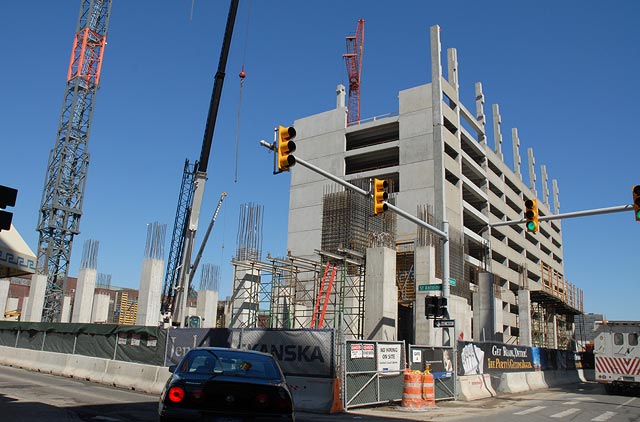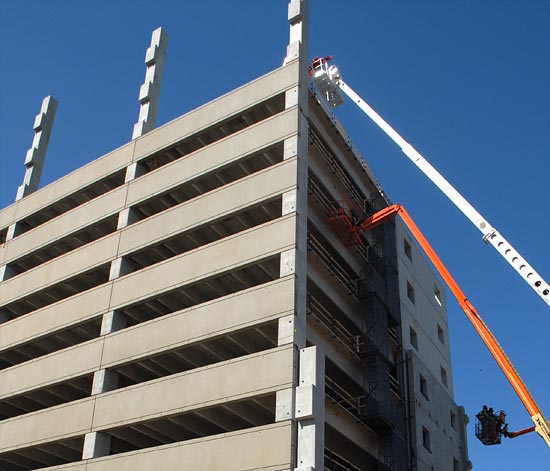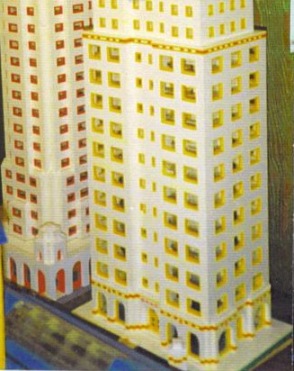Lowell Board Administrator Username: Lowell Post Number: 3743 Registered: 10-2003 |
... or anyone who understands this. I am curious about what appears to be a non-steel frame construction core of the new Greektown Hotel / parking lot. It appears to be lego-ed together with pre-cast concrete blocks with reinforced concrete columns rising in the SW corner. The use of cherry pickers, cranes and method of construction are quite interesting, but is this method now considered as strong and stable as a steel frame?   | ||
Psip Member Username: Psip Post Number: 1583 Registered: 04-2005 |
Lowell, that is pre stressed concrete construction. The pieces are held together with an epoxy like glue. They have been doing that with parking structures for years. Several years ago, a similar structure came a tumbling down when cracks developed in support columns. That happened in Las Vegas. The Zillwakee bridge is built like this. /not an architect //loves construction shows on Discovery (Message edited by psip on March 23, 2007) | ||
Psip Member Username: Psip Post Number: 1584 Registered: 04-2005 |
Heres a company that seems to specialize in this type of construction. Notice what building is on their home page. It is not pre stressed.  http://www.precastdesign.com/s ervices.htm lots of pictures in the projects section. | ||
Gistok Member Username: Gistok Post Number: 3880 Registered: 08-2004 |
And here's the same LEGO principle, but without the glue...   | ||
93typhoon Member Username: 93typhoon Post Number: 13 Registered: 04-2006 |
I have been to Shanghai a couple times and none of the dozen of high rises going up over there are steel frame structures. All appear to be reinforced concrete, and the buildings there are HUGE. They appear to be poured inplace rather then pre-cast. Gistok - the last time you posted lego pictures got me to get my lego out again - you've cost me a lot of money in the last few months! :-)) | ||
Crew Member Username: Crew Post Number: 1155 Registered: 02-2004 |
http://www.hamiltonform.com/ Texas company that produces the machinery that makes most of these panels around the country. | ||
Skulker Member Username: Skulker Post Number: 3699 Registered: 10-2003 |
SOP in deck construction these days. This process has been used in most, if not all, of the new decks in downtown. | ||
Detourdetroit Member Username: Detourdetroit Post Number: 272 Registered: 10-2003 |
parking decks are the third lowest and worst land use. | ||
Rsa Member Username: Rsa Post Number: 1056 Registered: 10-2003 |
lowell; it is indeed as safe and structurally sound as standard steel frame and/or reinforced concrete structure. in fact, it is extremely rare to see steel frame structure for a parking garage. most of the forces in a parking garage are compression from the weight of the cars, which concrete is ideal (and cheaper) for. parking garages are mostly repetitive bays, which lends itself extremely well to having the pieces constructed offsite and reassembled onsite. in fact, aside from the obvious cost benefits, these types of structures can be safer the poured in place concrete structures. there is more rigorous testing and a controlled environment inside the factory that makes these pieces. no need for weather, temperature, garbage, etc. considerations. there is also fewer "chefs" to spoil the concrete mix or drying process. for an examples of these structures around town: (like skulker sed) most new construction parking garages, the millender center was constructed almost entirely in this process, and the new portion of ford field was built almost entirely utilizing this method (upper bowl, structure, outside walls, etc.). it is my understanding that the hotel portion will be constructed using standard pour in place methods for it's structure (those columns in the foreground of your picture). this is probably differing from the parking garage structure due to it's more unique layout and probably a bit of politics that i can only speculate on. this method is also very safe and has been used for over 100 years. an excellent comparison/example around town is the lafayette towers and pavillion. hope this answers your question! -RSA (RockStArchitect) | ||
Lowell Board Administrator Username: Lowell Post Number: 3744 Registered: 10-2003 |
"The Zilwaukee bridge is built like this." Thanks for making me feel safer Psip. LOL. Nice explanation RockStarArch. Come to think of it, all the old multi-floor auto factories are poured in place columns with the main difference being that they tapered the tops into the ceilings. I have often heard that later math and engineering found that they were overbuilt. As for stability, I remember watching a wrecking ball taking on a ca. 3' column of the UniRoyal plant during that demolition and started counting. It took 13 direct hits with the ball before if finally collapsed. | ||
7even Member Username: 7even Post Number: 135 Registered: 03-2006 |
Speaking of the Zilwaukee. That bridge is great for photography. I recommend going under the beast (if you feel safe enough) to take pictures. | ||
Quinn Member Username: Quinn Post Number: 1214 Registered: 01-2005 |
Reinforced concrete replaced (or is replacing) alot of steel traditionally used in taller construction for its economy and increased strength properties. With the advent of newer construction technologies and materials, these concrete pillars and columns have tensile strengths that match traditional steel. Mind you, they do this by incorporating steel (rebar), which also happens to be the most costly part of the unit including material and design. Notice that all of the newer skyscrapers going up around the world are concrete. | ||
Danindc Member Username: Danindc Post Number: 2228 Registered: 10-2003 |
I'm not an architect, but I am a licensed Professional Engineer. Does that count? :-) Precast concrete construction is most economical when there is a regular, orthogonal geometry and repetitive elements. This technique thus lends itself very well to parking garages. The pieces are cast in the plant under a highly controlled environment, which allows for more ideal curing conditions than cast-in-place construction (CIP). The precast elements themselves are at least as strong as CIP, and you don't have the 28-day cure time, formwork, and shoring that CIP construction requires. Typically, about half the cost of a cast-in-place structure is due to the formwork, so you can see where this would be a great advantage in a non-revenue-generating building. Rockstarchitect is a little off in his analysis of the load-bearing. All structures have compressive forces, since they support gravity loads, not just parking garages. Parking garages, however, have lower design live loads than most other structures. For example, a parking surface is designed for 50 psf, whereas an office building is typically designed for 80 or 100 psf (depending on use of space, and the code used). In cast-in-place construction, though, there are typically shear walls (usually around the elevators) that resist lateral (wind and seismic) loads. In precast construction, the structure almost always relies solely on fixity at the joints between the columns and slabs to resist these loads. So the key, of course, is making sure you achieve that fixity in the field! I don't agree that precast is inherently safer than cast-in-place construction (or even steel construction). Cast-in-place construction tends to have better load distrbution characteristics, and hence redundancy, since the concrete is poured monolithically. The continuity provides myriad paths for load to travel and redistribute throughout the structure. As I stated above, the *really* key part to a safe precast structure is execution of the connection elements. Since the construction is not monolithic, connections need to be made between the parts, not unlike in a steel framed structure. Once the precast elements are fit together, the joint is typically grouted (Grout is basically concrete without the large aggregate in the mix.) to form a solid bond. That's the $.10 course. Rockstarchitect--if I may correct you (because you architects drive me nuts when you misuse jargon! LOL). Concrete doesn't dry--it cures in a process of hydration, where water molecules bond to the substrate. Drying = cracking = bad. | ||
Danindc Member Username: Danindc Post Number: 2229 Registered: 10-2003 |
quote: Concrete has virtually no tensile strength (ACI-318 advises the designer to neglect it), unless it contains some kind of fiber reinforcement. These materials and mixes, of course, are only in limited use right now, and are still being perfected in laboratories. These "tensile concretes" are useful only for flexural strength, however, as in a beam or a floor slab. Columns are designed for compression and flexure--not tensile strength. The most expensive part of concrete construction is not the steel reinforcing bars, but the formwork. | ||
Quinn Member Username: Quinn Post Number: 1215 Registered: 01-2005 |
Danindc, that's why I mentioned the steel (meaning rebar) and other technologies (didn't say but they include fiber and steel-strand additives). I don't mean to say that concrete itself is a match for steel, but that the combined and designed "unit" of pre-cast and cast-in-place concrete members match or beat traditional steel framing in strength and most importantly, cost. Would you agree? | ||
Rsa Member Username: Rsa Post Number: 1058 Registered: 10-2003 |
thank you for the more in-depth explanation dan. i was only intending on giving a quick and dirty layman's explanation for lowell. you can feel safe in knowing that i [mostly] use the correct terminology when on site and in construction management. | ||
Danindc Member Username: Danindc Post Number: 2231 Registered: 10-2003 |
^Not necessarily. It's really an apples-to-oranges comparison. To say "concrete is stronger than steel" is meaningless without any sort of context. If you want to get technical, steel is actually many times stronger in compression than concrete (50 ksi versus 4000 psi). Steel also has the advantage of being lighter, and architecturally, the columns almost always take up less floor space. A lot of building owners choose steel because the structure can be erected faster, which can lead to a quicker delivery time. I've prepared schematic designs for pricing purposes, and sometimes it's cheaper to go with steel, other times it's cheaper to go with concrete. A lot depends on the architecture, the local labor force, material availability, and a whole host of other factors. There are no hard and fast rules. If there were, the steel industry would be out of business. | ||
Psip Member Username: Psip Post Number: 1588 Registered: 04-2005 |
Thanks for these explanations. Very informative. One question remains, to me at least, doesn't steel still hold a Size/Space/Weight advantage over concrete? | ||
Danindc Member Username: Danindc Post Number: 2232 Registered: 10-2003 |
quote: yes/yes/yes | ||
Crew Member Username: Crew Post Number: 1156 Registered: 02-2004 |
concrete is still a better choice for getting rid of a body | ||
Professorscott Member Username: Professorscott Post Number: 276 Registered: 12-2006 |
Detourdetroit, What are the first and second worst land uses? I assume you'll say surface parking for one; what is the other? Just curious... | ||
Rsa Member Username: Rsa Post Number: 1060 Registered: 10-2003 |
that might've been my fault; i posted something in response to you thinking your response to quinn was to me. then i realized what was going on and deleted it. | ||
Fho Member Username: Fho Post Number: 60 Registered: 11-2003 |
Another question for architects: Are you hiring? I've got a useless degree which I'm going to shred and I've been drying/cracking/curing at a cash register for five years. Yes this is a total thread-jacking. HELP! | ||
Futurecity Member Username: Futurecity Post Number: 493 Registered: 05-2005 |
Let me guess about DD's list of Lowest and Worst Land Uses....Hmmm... 3. Parking Decks (he said) 2. Surface Parking Lots 1. Nuclear Waste Sites I think Nuclear Waste Site edges out Surface Parking Lot, although just barely . |